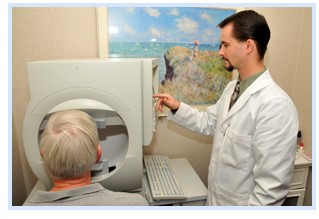WHAT IS GLAUCOMA?
Glaucoma is a disease characterized by the buildup of pressure in the eye causing damage to the optic nerve and resultant loss of peripheral vision. The eye is constantly producing and draining fluid internally. Both over production and under filtration of this fluid can cause glaucoma. The optic nerve is made up of about 1 million nerve fibers that carry information from the eye to the brain, allowing us to form images. As these fibers die you develop blind spots in your vision that can easily go undetected for years without formal testing. Glaucoma is one of the leading causes of blindness in people over 60, therefore early detection and treatment are key.
There are several types of glaucoma, the most common of which is chronic open-angle glaucoma. This is characterized by a slowly progressive, painless loss of vision that starts peripherally. It often goes unnoticed by the patient until more advanced disease affects central vision. At this point, it may become dangerous to drive. Although you may see a car directly in front of you, you may have trouble detecting a car in the adjacent lane or a bicyclist or pedestrian crossing the street. The insidious nature of this disease causes irreversible damage if not detected and treated early.
A less common type is acute narrow-angle or angle-closure glaucoma. This is an emergent situation caused by a rapid rise in pressure inside the eye which can cause permanent visual loss within 6 hours. This occurs in predisposed eyes when the angle where the drainage system is located is suddenly compromised, either by cataract progression or the use of numerous common medications. Symptoms of an acute attack of angle-closure glaucoma include severe eye pain or brow ache, redness, blurry vision, halos around lights, nausea and vomiting. This is an emergent situation that requires immediate intervention. Routine eye exams can detect whether you may be at risk for this form of glaucoma. Your doctor may recommend preventative laser treatment or cataract surgery.
WHAT ARE THE RISK FACTORS FOR GLAUCOMA?
While elevated pressure in the eye is one risk factor for glaucoma, there are several others advanced age, family history, race, past ocular trauma, thin corneas and near-sightedness. Some people develop glaucoma with “normal eye pressure”. Several systemic diseases including diabetes, hypertension, migraines, sleep apnea and anemia are predisposing factors.
HOW DO I KNOW IF I HAVE GLAUCOMA?
Routine screening eye exams are the best way to detect glaucoma. It is important to understand that the most common type of glaucoma has no symptoms until the disease is quite advanced. Because over half of the nerve fibers can die before there is a detectable change in vision, we use highly magnified lenses and three-dimensional imaging techniques to examine your optic nerve along with formal visual field testing to detect glaucoma in the earliest stages and monitor disease progression. Our office is equipped with the latest technology to assess, treat and monitor glaucoma.
WHAT IS THE TREATMENT FOR GLAUCOMA?
Treatment for glaucoma is aimed at lowering the pressure inside the eye to prevent further visual decline. There is no cure for glaucoma and no treatment that will restore vision once it is lost, therefore early detection and treatment are important.
In open-angle glaucoma, pressure can be reduced by various methods including eye drops, laser procedures and surgery in the operating room. Some patients achieve adequate pressure reduction with eye drops alone. Some patients are better candidates for laser treatment. SLT stands for selective laser trabeculoplasty. It is a painless procedure that is done in the office to help reduce pressure in the eye. Many patients require both topical and laser treatment. Few patients undergo surgery.
In narrow-angle glaucoma, treatment may initially be eye drops, followed by a laser procedure called a peripheral iridotomy. The YAG laser makes a small hole in the iris, the colored part of the eye so that pressure will not build up inside the eye. This hole is NOT a connection to the outside of the eye and is not visible to the naked eye. Our office has the latest state-of-the-art equipment to both diagnose and treat both forms of glaucoma.
CAN MY GLAUCOMA BE CURED?
There is no cure for glaucoma and neither medicine nor surgery will restore vision once it is lost. Only a comprehensive eye exam and evaluation of your individual risk factors can detect glaucoma early. You and your doctor will determine when treatment should be initiated and which treatment option is right for you.

